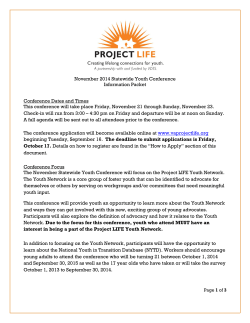
What happens next?
What happens next? • • • • • A Child Protection Worker or RCMP officer has been trained to listen to what you report, and determine what steps to take next. A Child Protection Worker will assess the child’s safety and well-being. They will work with the child and his or her family to make sure any issues are addressed. Under the law, you have done your part by making the call. Because of the child’s right to privacy, you will not be provided with any other information. For more information: Child and Family Services exist to protect and support children in the NWT and to encourage strong, healthy families. What to do if you think a child is being abused or neglected. This information is available as an audio recording in the NWT Official Languages at www.hss.gov.nt.ca or by phoning 1-855-297-5155. Vous pouvez obtenir les présents renseignements sous format audio dans les langues officielles des TNO sur le site www.hss.gov.nt.ca ou en composant le 1-855-297-5155. March February2012 2013 www.hss.gov.nt.ca www.hlthss.gov.nt.ca Possible Signs of Abuse Type of Abuse •injuries that do not match the explanation Emotional abuse causes harm or hurt to a child’s self esteem or self worth •non-medical bedwetting •child fails to thrive •extremely wellmannered, overly eager to please Sexual abuse a child has been molested or exploited sexually •unusual itching in genital area or injury of genital or anal area •age-inappropriate sexual knowledge or play •torn stained or bloody underwear •special ‘secret’ or new older friend •pregnancy •age inappropriate sexually explicit drawing or descriptions • What do I do if a child tells me that he or she has been abused? Stay calm and listen – if you are shocked or angry, the child may be scared to talk further. • Be supportive – let the child know they haven’t done anything wrong. Don’t ask ‘why’ questions. • Tell the child what will happen next – that you need to report the problem to a Child Protection Worker or RCMP officer to keep them safe. • Report what the child has told you to the Child Protection Worker or RCMP officer as soon as possible. Neglect A child is not being well-supervised, protected, cared for or provided for •can’t explain how they were injured •injuries that are •cringes or flinches if uncommon for a child of touched that age or development •aggressive or withdrawn •many injuries in different stages of healing •lots of headaches or stomach aches •sexually transmitted infection (STI) • It is not your job to investigate – talking to children about these topics is sensitive, and it is important that the investigation be done by a trained professional. It is your job to tell a Child Protection Worker or RCMP officer, who will know what to do. In the way the child acts or behaves Physical abuse causes hurt or injury to a child’s body. You Have a Duty to Report If you think a child is being abused or neglected, you have a duty to report it to a Child Protection Worker or RCMP officer. It is the law to report this. • You cannot ask someone else to report it. The report can only be made by the person who thinks a child may need protection. • Protecting children is a community responsibility. It is important that we all take action to protect our children. To the child’s body and/or health •unclean •unattended medical needs •hunger •depression •extremely aggressive or withdrawn •frequently miss school or activities •not clothed for the weather •regularly doesn’t have a lunch •tells you they are regularly left alone Exposure to Domestic Violence • irritability (infants) • fearful / angry • disruption to sleep and/or appetite •guilt / shame •stomach aches • difficulty concentrating • frequently absent from school or does not want to go home • headaches • age-inappropriate bed-wetting or thumb-sucking • physical injuries sustained trying to intervene * This is not a complete list of possible signs of abuse. If you are worried about a child, ask a Child Protection Worker or RCMP officer. • depression / self injury • physical aggresion •indirect bullying • substance abuse • early sexual activity
© Copyright 2025





















